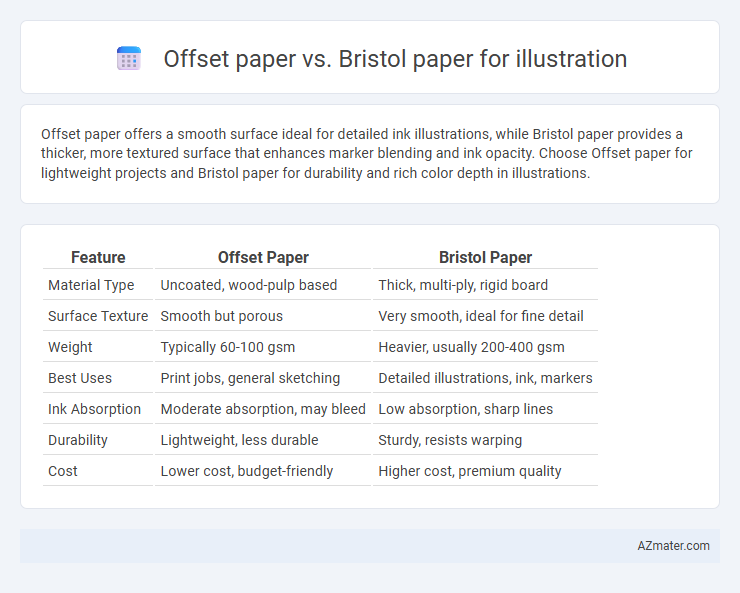Offset paper offers a smooth surface ideal for detailed ink illustrations, while Bristol paper provides a thicker, more textured surface that enhances marker blending and ink opacity. Choose Offset paper for lightweight projects and Bristol paper for durability and rich color depth in illustrations.
Table of Comparison
| Feature | Offset Paper | Bristol Paper |
|---|---|---|
| Material Type | Uncoated, wood-pulp based | Thick, multi-ply, rigid board |
| Surface Texture | Smooth but porous | Very smooth, ideal for fine detail |
| Weight | Typically 60-100 gsm | Heavier, usually 200-400 gsm |
| Best Uses | Print jobs, general sketching | Detailed illustrations, ink, markers |
| Ink Absorption | Moderate absorption, may bleed | Low absorption, sharp lines |
| Durability | Lightweight, less durable | Sturdy, resists warping |
| Cost | Lower cost, budget-friendly | Higher cost, premium quality |
Introduction: Understanding Offset and Bristol Paper
Offset paper, commonly used in commercial printing, offers a smooth surface with moderate thickness ideal for high-volume, cost-effective projects. Bristol paper features a heavier weight and a more durable, rigid texture, providing excellent support for detailed illustration techniques such as ink, gouache, and markers. Choosing between offset and Bristol paper depends on the desired finish, medium compatibility, and artwork longevity.
Defining Offset Paper: Key Characteristics
Offset paper, primarily used in commercial printing, features a smooth, matte surface with moderate weight and opacity, making it ideal for high-volume production runs. Its composition includes wood pulp with minimal sizing, resulting in excellent ink absorption but limited resistance to smudging or bleeding. Compared to Bristol paper, offset paper offers a cost-effective option but lacks the stiffness and durability preferred for detailed illustrations and mixed media artwork.
What is Bristol Paper? Features and Benefits
Bristol paper is a heavy, smooth, and durable paper made from compressed cellulose fibers, prized by illustrators for its rigidity and clean surface that supports various media including ink, markers, and pencils. Its multiple plies and high-quality finish minimize ink bleed and enhance precision, making it ideal for detailed line work and fine art illustrations. Compared to offset paper, Bristol paper offers superior thickness and surface consistency, providing excellent control and vibrancy in visual artwork.
Surface Texture Comparison: Smoothness and Tooth
Offset paper features a slightly rough surface texture with moderate tooth, providing good grip for dry media like graphite and colored pencils, making it suitable for detailed illustrations requiring precise control. Bristol paper, especially the smooth or plate finish type, offers a very smooth surface with minimal tooth, ideal for ink, markers, and fine line work, ensuring crisp, clean strokes without feathering. The choice between offset and Bristol paper depends on the desired surface smoothness and tooth, affecting how media interacts with the paper and the final illustration quality.
Weight and Thickness: Durability Factors
Offset paper typically has a lighter weight range of 50-120 gsm and is thinner, making it less durable for heavy illustration techniques, while Bristol paper ranges from 200-400 gsm and offers superior thickness for withstanding wet media and repeated erasures. The higher weight and density of Bristol paper contribute to its resistance to warping, buckling, and tearing, essential for long-lasting artwork. Artists seeking durability and structural integrity often prefer Bristol paper for detailed, mixed-media illustrations.
Medium Compatibility: Inks, Markers, and Paints
Offset paper excels with dry media like pencil and ink due to its smooth surface and lightweight texture but tends to absorb inks and markers quickly, causing potential bleed-through and less vibrant colors. Bristol paper, especially smooth vellum finish, provides superior compatibility for inks, markers, and paints by resisting bleed and allowing crisp lines and vibrant color layering without warping. Artists often prefer Bristol for mixed media illustrations where markers, ink pens, and light watercolor washes are combined to achieve precise detail and rich color saturation.
Color Vibrancy and Print Quality Differences
Offset paper offers a smooth surface with moderate color vibrancy, making it ideal for mass printing where cost-efficiency is key, but it can cause colors to appear slightly muted. Bristol paper features a heavier weight and ultra-smooth finish, enhancing color saturation and sharpness, resulting in vivid, high-quality prints with exceptional detail clarity. For illustrations requiring bold, vibrant hues and superior print quality, Bristol paper outperforms offset paper by providing a richer ink absorption and crisper image reproduction.
Workability: Erasing, Blending, and Layering
Offset paper offers moderate workability with smooth erasing and decent blending, making it suitable for light to medium layering in illustration projects. Bristol paper excels in durability, allowing for extensive erasing without surface damage, superior blending capabilities, and the ability to support multiple layering techniques due to its thick, rigid surface. Artists often prefer Bristol for complex illustrations that require detailed blending and repeated layering without compromising paper integrity.
Cost Efficiency: Price vs. Performance
Offset paper offers a cost-efficient option for large-volume illustration projects with moderate ink absorption and a smooth surface suitable for detailed work, typically priced lower than Bristol paper. Bristol paper provides superior durability and a thicker, more textured surface ideal for high-quality, professional illustrations, justifying its higher cost through enhanced performance and archival quality. Balancing price and performance depends on project requirements, with offset paper excelling in budget-conscious scenarios and Bristol paper preferred for premium, long-lasting artwork.
Which Paper is Best for Your Illustration Needs?
Offset paper offers a smooth surface with moderate thickness, ideal for pencil sketches and ink drawings requiring precise detail and easy blending. Bristol paper features a heavier weight and a more rigid texture, providing superior durability and excellent ink absorption, making it perfect for detailed illustrations with markers, pens, or water-based media. Choosing between offset and Bristol paper depends on your medium and desired finish: offset suits lighter, less textured work, while Bristol supports heavier, more intricate projects with sharper lines and vibrant colors.

Infographic: Offset paper vs Bristol paper for Illustration
 azmater.com
azmater.com